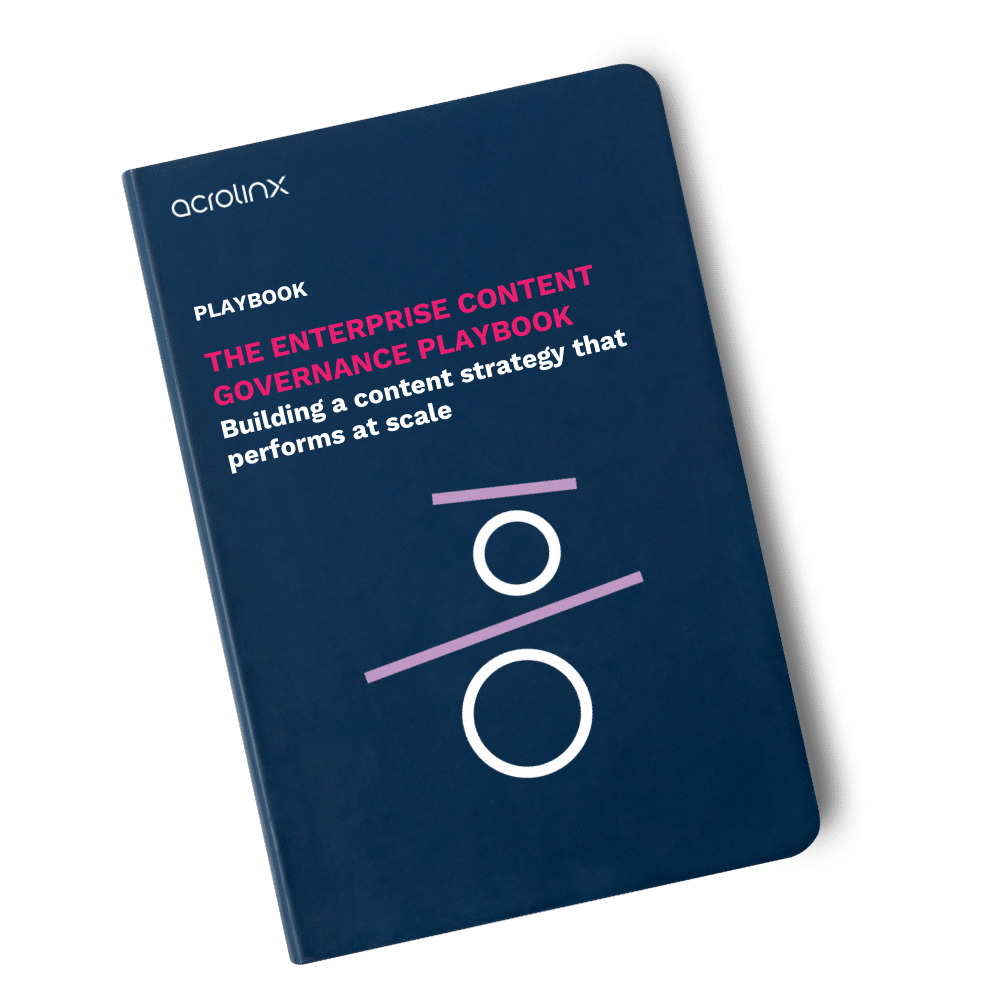
Content is at the heart of every customer experience. And as customer journeys transition from physical to digital touch points, content is becoming even more valuable, deployable, and measurable. Today, far more people are producing far more customer-facing content than ever before. And yet, 72% of brands say they fail to manage content strategically. This suggests that while every enterprise invests in content, the value of content is still underestimated. That’s why you need to perfect these content governance best practices. That way, you’ll experience the transparency and alignment you need to see better business outcomes, fuelled by content.
Tip: This blog gives you some handy tips to building a content governance plan for your enterprise content strategy. Are you ready for more? Diver deeper into content governance best practices in our new eBook “The Enterprise Content Governance Playbook.”
What is content governance?
Enterprise content governance is a systematic approach to capturing and digitizing your company’s content strategy; measuring your current content status; actively guiding content creation to achieve your stated goals; maintaining content over time; and improving overall performance. It applies equally to every kind of content in your company, including customer facing content and internal communications and process documentation.
The benefits of implementing a content governance model
What do you stand to gain from a content governance model, tailored to your specific enterprise content supply chain? The answer is simple. You’ll deliver more valuable content, both for your customers and your business.
From a business perspective, every piece of content you create has a purpose and an expected outcome. Depending on the type of content, that might be fewer support tickets, higher conversions, or deeper engagement. Your particular content goals will be unique to your business goals. When your content is aligned to your content strategy for your target audience, content type, channel, and business purpose – it’s likely it has everything it needs to deliver great results.
From the customer perspective, enterprise content governance is perceived as a seamless, unified customer experience across all your customer touchpoints. A clear and consistent customer experience sounds simple, but it’s surprisingly hard to accomplish when you consider the complex content challenges most companies face.
How to enhance content governance
To fuel a governance initiative you need to be a strategic change maker who can mobilize and enable your colleagues to realize tremendous, measurable value for your company.
Improving content governance without supporting technology requires manual efforts and standardized processes across content creation teams. A centralized style guide, comprehensive peer reviews, and role-based accountability are critical to maintaining consistency and compliance. Regular training programs help writers stay aligned with brand tone, terminology, and compliance standards. Additionally, setting up clear feedback loops and tracking KPIs, like readability and engagement metrics, allows for continuous refinement. However, managing these steps manually is time-intensive, costly, and difficult to scale, especially for large organizations needing to maintain high-quality content across diverse channels and regulatory environments.
With content governance software like Acrolinx, governance becomes streamlined and automated, reducing the burden on manual oversight. Especially when it integrates directly with popular authoring tools, providing guidance on brand voice, tone, and compliance in real-time, allowing creators to meet standards effortlessly. With the additional feature of automated checks content leaders can enforce quality by catching issues like inconsistent terminology, unclear phrasing, and regulatory non-compliance before publication. Additionally, Acrolinx offers customizable rules and analytics, allowing companies to set specific quality benchmarks and track improvements over time. This makes it easier for teams to produce content that’s consistent, audience-appropriate, and fully compliant at scale.
Common challenges in content governance
You’re likely someone who sees the untapped value in your enterprise content, held back by:
- Inefficient content creation, editing, review, and approval. Passing around content to a lot of people and ends up lost in inboxes and silos.
- Long delays in getting the content to market. Eroding its value and delaying its impact.
- Duplication of content. Resulting in wasted effort and contradicting assets.
- Expensive translation costs. Producing more and more content that businesses have to pay to get it translated.
All of this adds up to a huge waste of time and money. But even that isn’t the biggest cost. The biggest cost is confusing, fragmented, and inconsistent customer experiences.
Components of an effective content governance plan
When done well, content governance gives you transparency into your entire enterprise content. It allows you to scale your content production without straining your resources, and actively addresses fragmented and siloed workloads. As a result, your content delivers an impeccable customer experience, because it’s:
- Strategy-aligned — only publishing content that’s consistent, on-brand, and on-strategy.
- Fulfills its purpose— making sure every piece does exactly what it’s intended to do: helping your prospects and customers succeed.
- Easy to find and navigate — making it more discoverable and accessible.
- Delivers better, content-driven customer journeys — the big one. Creating consistent, high-quality experiences that will attract, retain, and satisfy customers.
Four content governance best practices worth improving
Content governance isn’t a new concept. However, older content governance models were never designed for today’s enormous content requirements. In today’s world you need to validate every piece of content against your content strategy, scale your content supply chain, and track performance over time. Without guiding you step by step on how to build a content strategy and begin content governance from scratch, here’s a few content governance best practices to inspire you to think holistically about your company content.
1. Regularly review your content strategy
Behind enterprise content governance is a robust, high-achieving content strategy. Once the strategy is clear, the governance gaps and necessary actions become clear too. For example, part of building out a content strategy is auditing your current content quality, and any gaps in content performance will inform your governance (and remedial) efforts. So if you suspect your content governance model needs a makeover, we recommend starting the process by reviewing your content strategy.
Want to learn more about how to create an awesome content strategy? Check out this eBook called “Content Strategy for the Modern Enterprise: The Ultimate Guide to Designing an Effective Content Strategy.”
2. Actively help content creators to raise their game
It might sound banal, but if you’re aiming to measure and track improved content performance over time, you need your content creators on board. Chances are you’ve put a lot of efforts into reviewing your content strategy and your content guidelines and processes – maybe you’ve even scoped out technology to help. The thing is, not all content creators have the “end goal” in mind when they create content. That’s because just about everyone creates content as a byproduct of their daily work – without needing to be a professional content writer.
Content governance involves everyone in the organization. You can make it easier by helping creators access your governance and guidance framework:
- At the point of creation. Guiding writers as they write, alerting them when they’re using an outdated product name, or missing a ™, or an opportunity to use an SEO key phrase, or straying from your target tone of voice.
- In their content creation tool of choice. Whether that’s Microsoft Word, Google Docs, WordPress, or any other tool they use now. With the right technology, creators can review their work, spotting errors and diversions from strategy, and applying natural language processing, AI, and writing guidelines to help them improve their content effectiveness and impact on the fly.
- With transparent metrics. The guidance sidebar shows the writer a numerical score, reflecting how close they are to delivering content that’s on-strategy, on-brand, and on-voice. They can see why they got that score and exactly how to improve it before pressing “submit” or “publish.”
Using technology can help bring your strategy to life, and govern your content across its entire lifecycle. The issue is, 82% of businesses feel they don’t have the right technology in place to manage their content. Which brings us to the next best practice.
3. Start small, but think big
Implementing enterprise content governance is a change management challenge. That means it needs an owner, sponsors, and a concerted team effort. Content governance advocates and leaders are effective because they tie their governance initiatives to their company’s most important strategic goals. Sure, you might start with a single department or content type, but it’s never too soon to start collecting data and proof points that will help you promote your solution to other stakeholders down the track. Because sure enough, you’re not the only one combatting inconsistent terminology and hard to read content! Remember:
- It’s never too early to start building out a business case for enterprise-wide content governance
- Collect success metrics as you progress with your content governance solution
- Be sure to include data on the cost and risk of doing nothing
- Show how a lack of content governance is actively damaging the business and the specific metrics your governance program
- Build a timeline to show how your own content has improved over time
Every department that owns customer-facing content will be a source of potential partners. You’ll need to package up your early wins to convince them to join your cause and frame potential benefits in terms they’ll understand, using their specific KPIs.
If advocating for content governance outside of your department sounds like a lot of responsibility, remember this: silos are part of the problem, because content that’s created in silos appears disjointed to your customers. In order to give your customers the best possible experience, they shouldn’t be able to detect inconsistencies in the style, tone, and terminology across your different channels and content types.
4. Automate content governance processes
Today’s content governance is all about finding ways to not only keep up with the demand for new content, but continuously monitor and improve existing content so that it remains relevant and valuable over time. Human editors and subject matter experts are great, even more so when they can use their time to make substantive edits that further enhance the value of content.
Automation technology can bring added efficiency and transparency into your content supply chain, taking the strain off human teams so they can enjoy more stimulating work. And, you can feel confident that your content is primed to achieve the strategic goals you’ve set for it, long before you’ve hit “publish.”
Greater content impact with less hassle
It’s no small feat to successfully govern your enterprise content strategy. But it’s essential for your business to navigate the complexities of an exponentially growing world of content. Legacy approaches to content governance are hard to sustain and scale as the pace of business quickens. If you want to meet your business goals and deliver an incredible customer experience, you need to prioritize the impact of your content. Well-governed content adds value through the entire customer lifecycle, from first touch to ongoing relationships and loyalty.
Content impact platforms like Acrolinx can help. Acrolinx is the leader in content impact. Our AI-powered software improves the quality, impact, and performance of enterprise content. Acrolinx customers increase their content’s value by streamlining its creation, governing it against established writing guidelines, and improving its impact over time. Acrolinx helps Fortune 2000 companies eliminate editorial bottlenecks, quality issues, budget overruns, and compliance risks from their content supply chain.
For a more comprehensive guide to starting or improving your content governance initiative, download our new eBook “The Enterprise Content Governance Playbook.” It offers a four-step framework for how to implement and measure a content governance strategy.
Are you ready to create more content faster?
Schedule a demo to see how content governance and AI guardrails will drastically improve content quality, compliance, and efficiency.

Kiana Minkie
She comes to her content career from a science background and a love of storytelling. Committed to the power of intentional communication to create social change, Kiana has published a plethora of B2B content on the importance of inclusive language in the workplace. Kiana, along with the Acrolinx Marketing Team, won a Silver Stevie Award at the 18th Annual International Business Awards® for Marketing Department of the Year. She also started the Acrolinx Diversity and Inclusion committee, and is a driving force behind employee-driven inclusion efforts.





